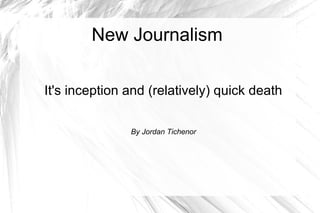
New journalism
- 1. New Journalism It's inception and (relatively) quick death By Jordan Tichenor
- 2. New Journalism New Journalism is a term that is used to describe a movement of journalism that was prominent primarily during the 1960's and 70's There is no one defining quality to describe what New Journalism is; every writer who is ascribed to this movement was only known for using 'non- traditional' techniques Therefore, it is a very broad term with examples from many writers utilizing a variety of different 'non-traditional' techniques
- 3. Pre-1960's/70's Journalistic writing style adhered to a strict and rigid set of rules Notably, these rules required the writers to: − Keep themselves out of the story − Follow a sraightforward, barebones writing style − Practice complete objectivity
- 4. New Journalism (at it's beginnings) One of the earliest examples of New Journalism was a 1962 Esquire article about heavyweight boxing champion Joe Louis, written by Gay Talese. Tom Wolfe, whose name would later become irrevocably tied to New Journalism, said of the article, − “(It) wasn't like a magazine article at all. It was like a short story. It began with a scene, an intimate confrontation between Louis and his third wife...”
- 5. New Journalism (at it's beginnings) According to Wolfe, Talese was the first to apply a novelistic or fictional style of writing to a journalistic piece (although this is hard to confirm) Talese would say in a panel discussion (printed in Writer's Digest in 1970) that despite the fictional look of his work and others like it, it was still “Fact reporting, leg work.”
- 6. Hell's Angels and Hunter Thompson Hunter S Thompson is often considered to be one of the biggest names in “New Journalism” In 1965, Thompson spent a year riding with the Hells Angels motorcycles gangs, and gave a running commentary of all the activities he observed and participated in, before being “stomped” by the gang.
- 7. Hell's Angels and Hunter Thompson This experience gave him the material for his first book, “Hell's Angels: The Strange and Terrible Saga of the Outlaw Motorcycle Gangs”, while being somewhat more traditional, still exhibited a couple major non-traditional features − Thompson put himself into the story (he used the word “I”) − He used a narrative style of writing − He passed value judgments on the events and people he was reporting on
- 8. The Electric Kool Aid Acid Test and Tom Wolfe Tom Wolfe, already a prominent journalist, and an avid proponent of New Journalism, spent time following Ken Kesey (“One Flew Over the Cuckoos Nest”) and his band of Merry Pranksters. Wolfe mainly focused on their heavy use of psychadelics, and what this meant in terms of the culture
- 9. Wolfe also put himself into the story, but kept his writing relatively objective. However, he not only wrote it as a narrative, but used a variety of poetic techniques as well, often describing things in a metaphorical way and formatting the text in odd ways in order to convey the sense of the Acid culture
- 10. In Cold Blood and Truman Capote Truman Capote was already an established novelist, being known for works such as “Breakfast at Tiffanys” and “A Christmas Memory” He began writing “In Cold Blood” after reading an article in The New York Times about the murder of a family in Kansas
- 11. Capote called the book a “nonfiction novel”, as it was written in the manner of a novel (as were the previous two books) More than describe the crime, it described the effect of the crime on the killer and the community, thereby interjecting a great amount of personal opinion and views into the work, while accurately reporting the events
- 12. The similarities and the discrepancies There were no “rules” in terms of this type of journalism. Thompson, Wolfe, and Capote all seemed to stress different things. Thompson seemed to want to do something completely different than had ever been done before and throw out all the rules
- 13. Some light might be shed on this mentality from how Wolfe described Thompson − “Hunter's life, like his work, was one long barbaric yawp, to use Whitman's term, of the drug-fueled freedom from and mockery of all conventional proprieties that began in the 1960s. In that enterprise Hunter was something entirely new, something unique in our literary history.” Tom Wolfe from his Wall Street Journal piece on Hunter Thompson 2/22/05
- 14. Wolfe and Thompson seemed to appreciate each others work, although they acknowledged that they had different empahsis' − “We were a new kind of writer, so I felt it was like a gang. We were each doing different things, but it was a natural kind of hook-up.” − Hunter S. Thompson, The Art of Journalism No.1, Interviewed by Douglas Brinkley, Terry McDonell
- 15. Thompson seems to have never commented on Capote's work, but Wolfe was quite critical of “In Cold Blood,” as shown in his 1976 essay in Mauve Gloves & Madmen, Clutter & Vine, titled “Pornoviolence”. − "The book is neither a who-done-it nor a will-they-be-caught, since the answers to both questions are known from the outset ... Instead, the book's suspense is based largely on a totally new idea in detective stories: the promise of gory details, and the withholding of them until the end."
- 16. Death of New Journalism In a 1975 issue of Commonweal, Thomas Powers asked “Whatever happened to the New Journalism?” In 1981, Jocera published an article in Washington Monthly in which he asserted that New Journalism was dead, and blamed it on Hunter Thompson taking the idea too far.
- 17. Works Cited Krim, Seymour. “Why They Aren't Writing the Great American Novel Anymore,” Esquire, December, 1972, p. 152. “The Birth of 'The New Journalism'; Eyewitness Report by Tom Wolfe” New York, February 14, 1972. p. 45